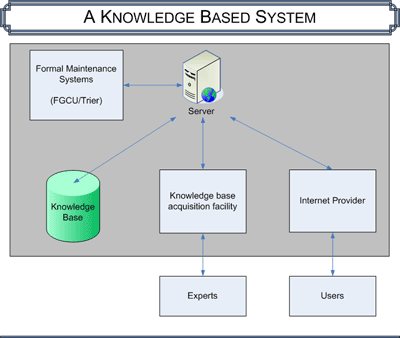 Einleitung
Einleitung  Knowledgebase
Knowledgebase
A more complete version of this introduction was published by Prof. Roy A. Boggs to honor Prof. Winfred Lenders "ad fontes, Hartmann von Aue: A Knowledge Base for Philology", in: Computerlinguistik: was geht, was kommt? – Computational linguistics: achievements and perspectives. Festschrift für Winfried Lenders, ed. by Gerd Willée, Bernhard Schröder and Hans-Christian Schmitz, Sankt Augustin: Gardez!-Verlag 2003, pp. 22-55.
Introduction
A knowledge base is simply a collection of data. The value of a knowledge base is determined by the data it contains and their relevance for a given subject. For an international enterprise, a knowledge base contains data that reflect its operations. For example, what does the enterprise know about itself? Or, which facts are important for the present and future direction of the enterprise? A knowledge base contains answers to such questions. It also presents answers to these questions in a format that is useful to its users - in its international environment.
A knowledge base performs the same functions for the medieval German poet Hartmann von Aue. That Hartmann was chosen as the first candidate for such an endeavor is not surprising. The golden age of medieval German literature was unique in its origins and its development. Not only were the works of Hartmann von Aue of a central importance for this development, today his works still enjoy a large audience. It is not only the value that has been placed on them by poets such as Gerhart Hauptmann, Henry Wadsworth Longfellow and Thomas Mann that makes them important. Today his works continue to be translated into English (Iwein: 1979, 1984, 2001; Der Arme Heinrich: 1984, 2001; Erec: 1984, 1987, 1987, 2001; Gregorius: 2001; Lament: 2001; and the Lyrics: 2001). Der Arme Heinrich was recently presented over the radio in Switzerland; and a stage version was produced in Munich by Tankred Dorst (1996). Alone in the past decade thousands of copies of Der Armer Heinrich - the medieval German Text as well as translations - have been distributed.
Along with the primary goal of presenting a knowledge base for Hartmann von Aue, this knowledge base has a secondary goal of demonstrating the potential for making important historical works and supporting material available to as wide an audience as possible. This goal should in no way be minimized. In view of the ever-shrinking financial support in the world for literary-historical scholarship, the Internet offers an inexpensive avenue to make such scholarship and the necessary tools available. At the same time, it instantly increases access to those who want to learn and who want to contribute.
The Knowledge Base System
A knowledge base answers questions about what we know and how we know it. It is continually renewed, continually improved, and it mirrors our knowledge.
The process can be seen in the following image.

The process begins, at the first level, with data collection. The decision to acquire data is in every data system the most important. Experts determine which data, whether they be in the form of texts, numbers, pictures, or anything else, need to be collected. These data are then acquired, entered and modified in necessary formats - in consultation with data management experts - and stored in a knowledge base. This level is represented in the image by the Experts, the knowledge base acquisition facility and the knowledge base itself. This is the data acquisition level.
The next important level is the maintenance of the data within the system. Not only must pieces of data never be lost, but the data themselves must be efficiently stored and be retrievable in a suitable and meaningful manner; and under no circumstance must the system collapse under the weight of its data. This step involves experts who not only are familiar with the data but who can also manage the data. Data structures must not only represent content, they must also be physically well organized. In the image above, this level is represented by the server and the elements that are related to them. This is the data management level.
The third level is data representation/presentation. Data within a system are of no value unless they can be presented in manner that is useful to someone. For the Internet, considerations such as size, format, color, links, clients vs. server scripting, etc., play a role in making the data meaningful. This requires another level of expertise that has only recently been recognized. The success of an enterprise often depends upon how its data are presented. The Internet Provider and the User represent this level. This is the data presentation level.
The three levels of expertise - data acquisition, data management, data presentation - connect the Expert with the User. In between are those who make it all work. Success depends upon all three levels of expertise working together for a common goal. In the end, however, success is ultimately determined by the user.
The Hartmann von Aue Knowledge Base
In the case of the Hartann von Aue (HvA) Knowledge Base the data acquisition experts are the philologists, who determine manuscripts, create transcriptions, produce critical texts and provide supporting materials such as dictionaries and concordances. The data management experts are the information systems specialists, with a background in philology, who identify data structures, create data bases and process items such as images. Internet programmers are the presentation experts who design interfaces, write script, and present data for interaction with the user.
The HvA Knowledge Base represents the total efforts of all three levels of experts, whereby each makes a special contribution. In this process, not only does the user benefit, but scholarship in general. Hartmann is presented to a world-wide audience and the Knowledge Base is open to contribution from anyone, by anywhere, at anyone.





